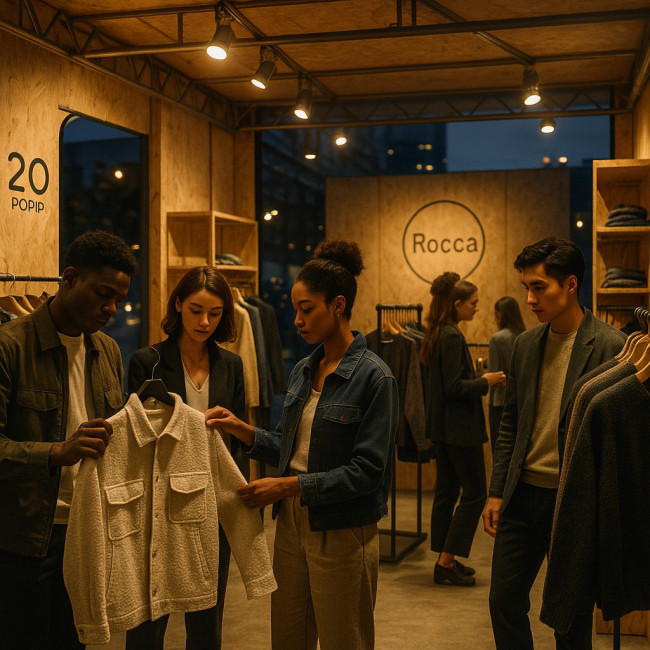Planning a pop-up showcase: steps for clothing designers to gain buyers in 2025
Want to turn curious passers-by into confirmed stockists? A well-planned pop-up showcase can compress months of outreach into one immersive evening. Follow this 2025-ready roadmap to pick the right dates, budget smartly, attract the press and—above all—convert visitors into paying buyers.
The 2025 case for a pop-up showcase

Wholesale buyers crave tactile proof before they commit to emerging labels. Even with advanced 3D sampling, seeing and feeling garments live is still the fastest trust trigger. A pop-up showcase delivers that experience without the six-figure spend of a full fashion-week runway. It also:
- Generates time-bound urgency—FOMO accelerates purchase orders.
- Creates rich content for socials, press kits and future lookbooks.
- Lets you test pricing, sizing and merchandising layouts in real time.
- Feeds data to refine your next collection release.
Pop-up showcase vs. traditional trade fair
| Metric | Pop-up showcase | Trade fair booth |
|---|---|---|
| Average cost (city tier 2) | €8 000 – €18 000 | €20 000 – €40 000 |
| Brand control | Full (venue, decor, music) | Shared ambience |
| Lead quality | Highly targeted invite list | Mixed footfall |
| Press visibility | Local lifestyle & niche media | Industry trade press |
| Data ownership | 100 % yours | Often gated by organiser |
12-week timeline to launch a profitable pop-up
Use this backwards-planning framework to stay on track.
- Week 12-10 – Concept & goal-setting
Define collection story, target buyer persona and sales target (e.g., 15 new wholesale accounts). - Week 10-8 – Venue scouting & negotiations
Shortlist high-footfall spaces. Negotiate turnover-linked rent to protect cash flow. - Week 8-6 – Partner outreach
Line up local DJs, sustainable caterers and micro-influencers for cross-promotion. Review seasonal event calendars to avoid date clashes. - Week 6-4 – Production lock
Freeze sample set, prep size runs for at-event preorders. Secure display fixtures. - Week 4-3 – Marketing rollout
Launch teaser reels; embed interactive lookbooks on your site. Add a high-intent RSVP form. - Week 3-2 – Press & buyer invites
Personalised pitches to boutiques discovered via the Artfolio clothing-designer event directory. Offer time-slotted previews for serious buyers. - Week 2-1 – Operations drill
Stress-test lighting, payment terminals and live streaming gear. Print look-sheets with scannable QR codes. - Day 0 – Showcase
Collect buyer cards, scan badges, record style-level interest in a CRM. - Day +1 – Follow-up
Send line-sheets, price lists and 24-hour order incentives. - Day +7 – Data review & upsell
Segment warm leads, schedule virtual fittings and propose minimum-order bundles.
Budget levers that multiply ROI
Pop-ups can spiral in cost when décor and staffing snowball. Anchor your spend to conversion drivers:
- Modular fixtures—rent recycled plywood plinths; reskin graphics next season.
- Shared staff—train fashion-school interns in product knowledge; reward with portfolio credits.
- Smart tech—use free RSVP tools and affordable NFC hangtags; skip adhoc agency fees.
Need capital? Blend early-bird wholesale deposits with pre-order crowdfunding (see crowdfunding capsule collections) to finance sampling and promotion simultaneously.
Location scouting hacks for 2025
Buyers want convenience. Evaluate venues on:
- Public-transport access within 5-minute walk.
- Neighbourhood footfall that matches your price point (luxury streets vs. arts districts).
- Ambient lighting—natural light cuts photography costs and flatters textiles.
- Existing permits to minimise admin time.
For eco-minded collections, consider BREEAM-certified spaces. Green credentials improve press pick-up and align with buyers' CSR goals.
Designing an immersive micro-runway
Instead of a traditional catwalk, choreograph a 90-second loop where models walk among visitors. This “immersive aisle”:
- Encourages tactile interaction without security risks.
- Fits tighter spaces—think 20 m clear path, not 40 m.
- Feeds social content as buyers film close-up details.
Hire a stylist who can turn looks in 30 seconds backstage. Re-style key pieces live to demonstrate versatility and justify wholesale mark-ups.
Marketing stack: pre-launch to post-event nurturing
Pre-launch
- Email drips—three-part sequence: teaser, value, urgency.
- Geo-targeted ads—1 km radius around venue; bid highest during lunch breaks.
- Co-branding—offer local cafés limited-edition tote bags; each bag includes invite QR.
During event
- Live polls: “Vote next colourway” to capture emails.
- UGC wall: auto-pull branded hashtag posts onto a screen.
- Livestream via hybrid showcase best practices for remote buyers.
Post-event
- 48-hour replay link gated behind lead form.
- Personalised style-bundle quotes based on scans.
- Invite VIP buyers to a private virtual showroom demo.
Tech integrations that boost reach
In 2025, expect buyers to scan before they speak. Integrate:
- NFC hangtags—tap to open spec sheets, care videos and bulk order form.
- AR try-on mirrors—buyers visualise alternative prints without running back-of-house.
- POS with wholesale module—instant pro-forma invoices prevent post-event inertia.
Match digital assets to on-site storytelling so data flows seamlessly into your CRM.
Day-of operations checklist
- Sound check: maintain 70 dB max so conversations flow.
- Lighting test: 5500 K LEDs for colour accuracy.
- Inventory log: barcode every garment leaving stock room.
- Staff briefing: rehearse pitch, sizing answers and sustainability proof points.
- Emergency kit: steamer, stain remover, spare cables, printed look-sheets.
Convert visitors into long-term buyers
Closing a wholesale order rarely happens on the spot. Build layered follow-ups:
- Two-hour rule—send digital line-sheet while memory is fresh.
- Seven-day spec consult—offer custom pack ratios for their store data.
- Thirty-day reorder incentive—tiered discounts on supplementary sizes.
Use journey tagging: attended-but-no-order, ordered-small, high-potential. Automate nurture emails unique to each group. The goal: turn first order into standing seasonal contract.
Are you pop-up ready? (Mini-quiz)
FAQ
- What is the ideal duration for a pop-up showcase?
- One to three days. Shorter events create urgency yet allow buyers multiple visit slots.
- How many SKUs should I display?
- A curated 20-30 styles keep focus and simplify ordering. Offer colourway swatches rather than full racks.
- Do I need liability insurance?
- Yes. Most venues require at least €2 million public liability cover.
- Can I run a pop-up on a micro-budget?
- Yes—partner for venue sponsorship, reuse modular fixtures and activate pre-order funding.
- How soon should I follow up with buyers?
- Within two hours for digital assets, 24 hours for a personalised call, and seven days for tailored pack suggestions.
Ready to secure buyers? Download the checklist, block your showcase date and start pitching venues today.











